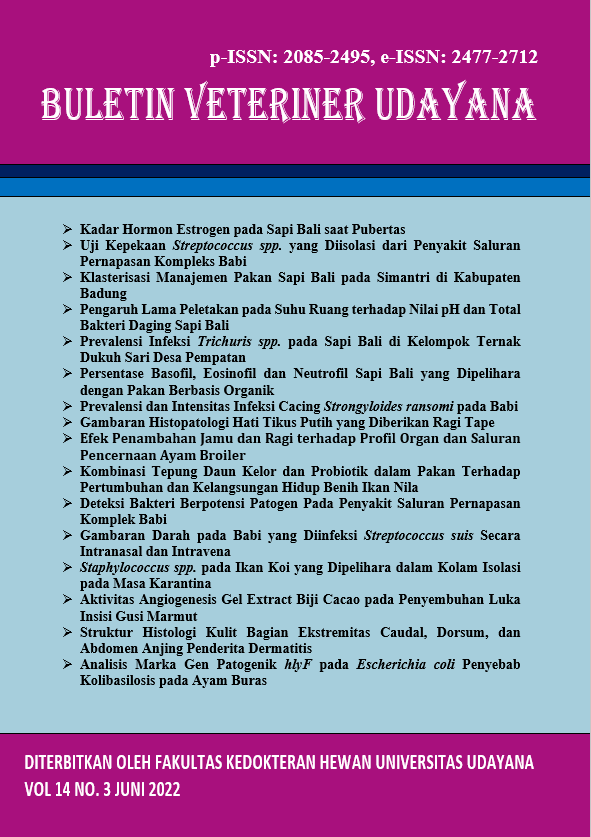PERCENTAGE OF BASOPHILS, EOSINOPHILS, AND NEUTROPHILS IN BALI CATTLE BLOOD BASED ON ORGANIC FEED
Abstract
One of the Bali cattle breeding maintenance is organic-based feeding. Organic-based feed is likely to not be as optimal as the composition of feed like feed in general, such as minerals and other organic substances. The condition and composition of the feed can affect the number of blood leukocytes and cause changes in the percentage of leukocyte cells such as basophils, eosinophils and neutrophils. This study aims to determine the percentage of basophils, eosinophils, neutrophils in bali cattle blood based on organic feed. This study was carried out on a farm owned by residents of the Village of Bulian, Kubutambah District, Buleleng Regency. Samples in the form of blood taken from 10 female bali cattle by vein using venoject. Next, blood smear preparations were made and then fixed and stained by Harris Hematoxillin-Eosin (HE). Percentage of basophils, eosinophils, neutrophils calculated by cross-sectional method. Data obtained and analyzed with descriptive quantitative. The results showed that cattle raised with an organic based maintenance system experienced basophilia, eosinophilia, and neutropenia.
Downloads
References
Andung FL, Suwiti NK, Kendran AAS. 2018. Agranulosit bibit sapi bali pada berbagai umur di Nusa Penida. Bul. Vet. Udayana. 10(1): 76-80.
Ganong WF. 1999. Buku Ajar Fisiolog Kedokteran. Jakarta. EGC. Edisi 17. Pp. 536 - 537, 552 - 554.
Gentile NT. 2006. Decreased mortality by normalizing blood glucose after acute ischemic stroke. Acad. Emerg. Med. 13(2): 174–180.
Graser H. 2003. Option for genetic improvement of bali cattle assessing the strenghts and weakness of alternative strategis. Proc. Seminar Strategies to Improve Bali Cattle in Eastern Indonesia. Australian Centre for International Agricultural Research. Denpasar.
Jannah N. 2012. Strategi pengembangan sapi bali (Bos javanicus) pada sistem pemeliharaan ekstensif dan semi intensif Desa Tawali Kecamatan Wera Kabupaten Bima Nusa Tenggara Barat. Bogor. Balai Penelitian Ternak Bogor.
Keller MA. Richard SE. 2000. Passive immunity in prevention and treatment of infectious diseases. Clin. Microbiol. Rev. 13(4): 602–614.
Knowles TG, Edwards JE, Bazeley KJ, Brown SN, Butterworth A, Warris PD. 2000. Changes in the blood biochemical and haematological profile of neonatal calves with age. Vet. Rec. 147: 593 – 598.
Nordenson NJ. 2002. White Blood Cell Count and Differential http://www.Lifesteps.com/gm.Atoz/ency/white_blood_cell_count_and_diffe rentil. Diakses 28 Mei 2018
Puslitbangtan, 2001. Pengelolaan tanaman terpadu: pendekatan inovatif sistem produksi padi. Warta Penelitian dan Pengembangan Pertanian. 23(2).
Putra IE, Suwiti NK, Suatha IK. 2016. Identifikasi sel granulosit leukosit pada sapi bali. Bul. Vet. Udayana. 1-10.
Rahayu SS, Suwiti NK, Suastika P. 2016. Struktur histologi dan histomorfometri granulosit pada sapi bali pasca pemberian mineral. Bul. Vet. Udayana. 8(2): 151-158.
Schalm OW. 2010. Veterinary Hematology. Edisi ke-6. Lea & Febiger, Philadelphia.
Sujani D, Piraksa IW, Suwiti NK. 2016. Profil mineral magnesium dan tembaga serum darah sapi bali yang dipelihara di lahan tegalan. Bul. Vet. Udayana. 6(2): 119-123.
Suwiti NK. 2010. Deteksi histologik kesembuhan luka pada kulit pasca pemberian daun mengkudu (Morinda Citrofilia Linn). Bul. Vet. Udayana. 2(1): 1-9.
Suwiti NK, Putra S, Puja N, Watiniasih NL. 2012. Peningkatan produksi sapi bali unggul melalui pengembangan model peternakan terintegrasi. laporan penelitian prioritas nasional (MP3EI) Tahap I. Pusat Kajian Sapi Bali Universitas Udayana.
Thrall G, Lane D. 2004. Compliance with pharmacological therapy in hypertension: can we do better, and how? J. Human Hypertension. 18: 595–597.
Triana E, Nurhidayat N. 2006. Pengaruh pemberian beras yang difermentasi oleh Monascus purpureus Jmba terhadap darah tikus putih (Rattus sp.) hiperkolesterolemia. J. Biol. Divers. 7(4): 317-321
Weiss DJ and Wardrop JK. 2010. Schalm’s Veterinary Hematol Blackwell Publishing, Iowa.





